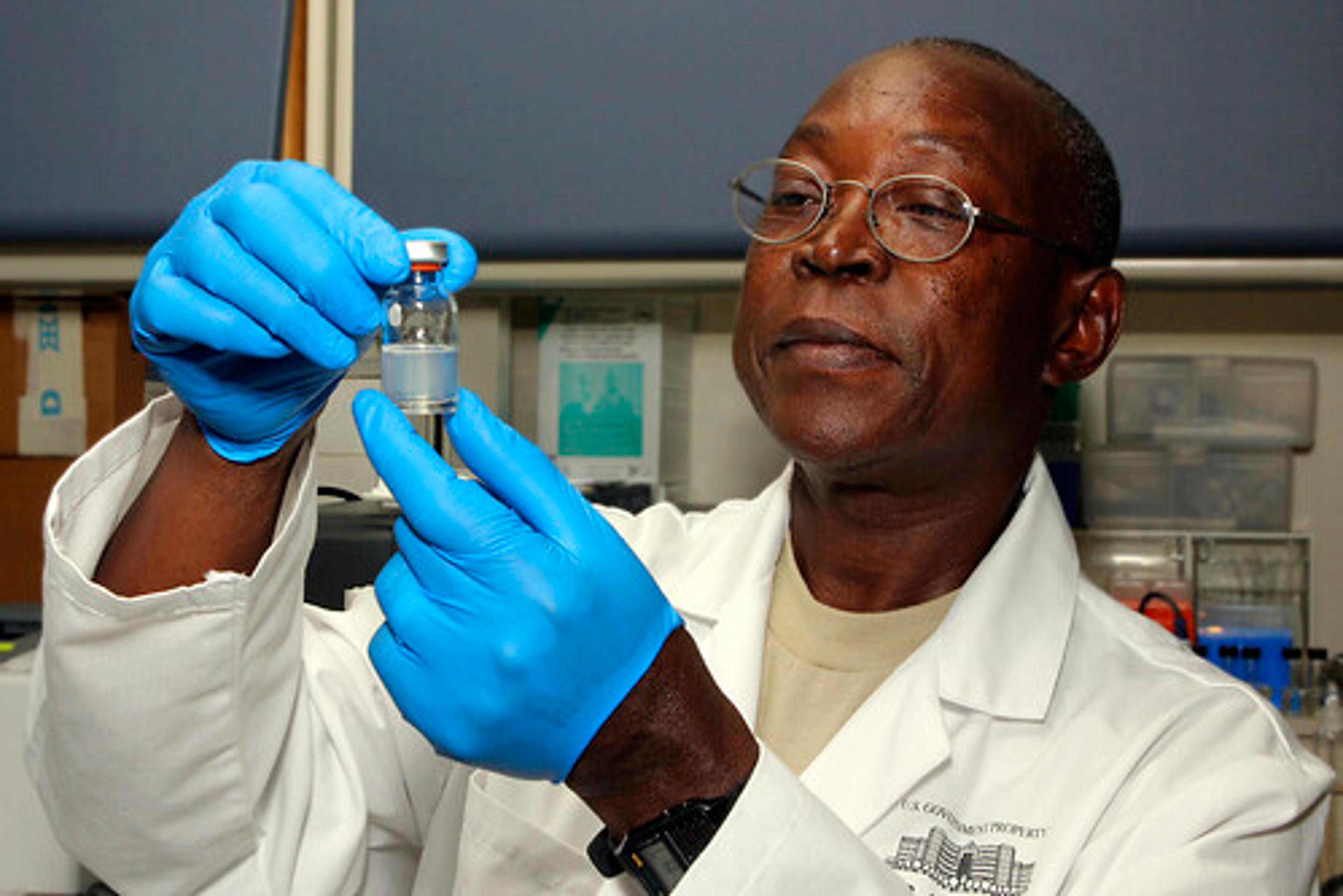Should we give to SCI or fund research into schistosomiasis?
This blog post summarises my research on the cost-effectiveness of medical research. The full report can be found here. I’d greatly appreciate comments on the full report!

At the moment, one of Giving What We Can’s top recommended charities is the Schistosomiasis Control Initiative (SCI) which distributes treatments for neglected tropical diseases to endemic regions. This has been demonstrated to be a highly cost-effective intervention, with a seemingly huge impact on people’s lives. It is great to do something that seems so obviously good, and effective.
However, it may be that there are even cheaper, more effective interventions out there. Perhaps we can discover a vaccine for schistosomiasis, or some insecticide that can disrupt their life cycle once and for all. Such interventions could be cheaper, and more effective, than the existing drugs for schistosomiasis.
If so, it might be worth funding research in order to develop these interventions. This one-off cost would open up such great new funding opportunities that it could be even more efficient than giving to SCI, in the long-run. It might be worth spending money on research now, that would pay off by having an even bigger impact on people’s lives later on.
So to find out how to do the most good, we should consider this other option: should we fund medical research?

Neglected, important, tractable?
When selecting a cause you want to find something which is a significant problem (important), which you can have a big impact upon (tractable), and which others have ignored (neglected). This helps to ensure that you have a big impact, and are not duplicating work done by others.
Neglected
There is an incredible amount of money spent on medical research - billions of dollars per year.[1] So how could medical research be neglected?
Well, when we look at the breakdown of that spending, we find that it is incredibly uneven. Diseases that cause 90% of the disease burden receive less than 10% of the medical research funding, an absurdly low figure.[2] And of 1393 drugs developed between 1975 and 1999 only 16 - just over 1% - were targeted at tropical diseases or tuberculosis, despite their significant disease burden. The tropical diseases that affect the poorest people in the world receive little funding.
Why? Most of the funding for medical research comes from governments in high-income countries, or from pharmaceutical countries focused on lucrative high-income markets. High-income countries have the money to spend on research, and they spend it on their own problems, whilst low-income countries can’t afford research, despite the massive impact it could have.[3] This is just what we see in health more generally: much more is spent per capita in higher-income countries, although a great amount of the disease burden is in lower-income countries.[4]
It therefore seems that tropical diseases are relatively neglected, and for the rest of this post I will focus on these diseases.
Important
At first pass, it seems clear that this health research could be very important. It could find vaccines, drugs, diagnostics, and vector controls that could help to bring about the (near-) eradication of diseases that adversely affect millions of lives. But things aren’t quite so simple.
It may be that, for some diseases, no more health research is needed. For instance, it may be that, since the interventions against schistosomiasis are so cost-effective, there is no need for a vaccine, and if this is the case, schistosomiasis research is less useful.[5] We need to focus on the diseases for which this is not the case, where research is still important. It requires specific scientific knowledge to ascertain which diseases are most promising in this respect (something I discuss later).
One example of a disease for which a vaccine is needed is HIV. HIV not only has a massive disease burden, but is also a relatively expensive disease to treat, sucking up healthcare funding. Whilst there are some current control methods, like male circumcision and condom use, they are difficult to popularise. Having another tool to block transmission could greatly reduce the disease burden, and save healthcare spending that could be used on other diseases.[6]
Tractable
Having established that some tropical diseases appear to be both neglected and important, we turn now to find out how tractable research is.
This can be simplified to asking: How much will it cost to produce a new drug or vaccine for this disease? This is a difficult question to answer. By its nature, research is the exploration of the unknown, and so we don’t know very much about the new drug or vaccine that will come out at the end of it (if we did, we wouldn’t have to do the research!). This means that we don’t know very much about the type and amount of research needed to get us to that finished product.
Nevertheless, we can get a reasonable idea by examining past drugs, and seeing how much it cost to develop them. One highly cited study finds that the average cost of developing a new drug is $800m.[7] There are some reasons to think that this might underestimate current costs somewhat: for instance, the figure is over 10 years old, and drug development costs appear to rise above inflation.[8] The true figure is therefore probably a little higher than this.
But it isn’t the average figure we interested in. We know that some diseases are likely to be much more simple than others. What is the development cost likely to be for the types of tropical disease that we are interested in?
Tropical disease research tends to be carried out by public-private partnerships, rather than by the private sector alone. It appears that these partnerships face lower costs, since their charitable purpose allows them to gain donations of equipment, or discounted prices, reducing their costs. Moreover, tropical disease research is often carried out in low-income countries, where trials are less expensive. Finally, fewer clinical trials are needed for the development of some of these drugs.
It therefore seems that the out-of-pocket costs of this sort of development may be less than half of the cost of private development, or less than a quarter if you account for the cost of capital, perhaps in the region of $150m-$178m.[9] So this sort of research could in general be significantly cheaper than most drug research could be.
However, it is important to note that this will vary by disease, and that some tropical diseases look particularly difficult to produce drugs for. For instance, HIV is a particularly complex disease, making vaccine development tricky.[10] This means that it is expected to cost much more to develop a vaccine for HIV - perhaps more like $15bn-$20bn than $800m.[11]
In order to truly assess the tractability of research into a specific disease, we need to investigate the particular scientific challenges relating to that disease. Though tropical diseases may be cheap to develop drugs for on average, we need to know the scientific challenges that a particular disease poses in order to fully assess tractability.
Estimating the cost-effectiveness of medical research
In the last section, we saw how much variation there was in neglectedness, importance, and tractability between diseases. We narrowed our focus onto a particularly promising set of diseases: tropical diseases (which are neglected relative to other diseases), that need a new type of treatment (and so are important), and that don’t seem to present particular scientific challenges (so are tractable). Homing in on the right disease is really important.
But it is also useful to come up with a rough analysis of the cost-effectiveness of interventions, to see if it is plausible that research into any of these diseases could be better than Giving What We Can’s current top recommended charities.
Giving What We Can’s top charities tend to be able to avert a DALY (a disability-adjusted life-year, which is a measure of health) for around $50. When I searched for estimates of the cost-effectiveness of research into tropical diseases, I found estimates ranging from $8-$235/DALY, with most estimates grouped around $10-$100/DALY. Inspecting the biases of these papers, it seems that these papers somewhat overestimate the effectiveness of research. The true figure for tropical diseases as a whole could be more like $50-$300/DALY.
However, there is likely to be a great variation in effectiveness between diseases, so these estimates indicate that the very best research could well do better than $50/DALY. The right type of research could be the most effective intervention we’ve yet found.
How can we find high impact research?
Unfortunately, we can’t yet be sure what these best opportunities are. But it is worth doing more research to find out what the best interventions are. We need to answer three questions.
First, we need to look at the current treatments available for tropical diseases, and the scientific challenges to creating new treatments. This will allow us to identify for which diseases research is both important and tractable. Detailed scientific knowledge will be needed to answer this question.
Second, we need to gain a deeper understanding of the current funding situation, and which types of funding are most promising. There are different ways to fund disease research: we can pay people to conduct studies (‘push funding’) or offer them prizes when they discover new treatments (‘pull funding’). Each of these types of funding has advantages, but each is likely to be especially suited to particular situations. A detailed analysis of how to use these funding mechanisms could help us to maximise impact.
Finally, we should develop better models for cost-effectiveness. Many of the cost-effectiveness studies cited above failed to account for certain epidemiological considerations, or considered the average rather than the marginal impact of donations. Fixing these problems would allow us to build more reliable models of cost-effectiveness, which would help us to compare research to other types of intervention.
Should we fund research now?
That is a research agenda. But we still need to ask: should we fund research into schistosomiasis, rather than give to SCI?
For now, the answer is ‘no’. We shouldn’t fund research just yet. While it seems likely that research overall is relatively effective, and that some research can be more effective than the current top recommended charities, we just can’t be certain enough about how effective it is, or which diseases need research the most. I expect that giving to tropical disease research will have a lower impact than giving to SCI.
But in a few years, as we understand research better, I expect that to change.
In the meantime, it may be a good idea to put more time and money into answering the three questions I set out above.
References and Notes
- Applied Clinical Trials Online: Sizing Clinical Research Market
- COHRED: Assessing the Efficacy of Health Research as aDevelopment Strategy in Poverty Reduction - Strategy Papers, p. 6
- Kinge et al. notes a strong correlation between Norwegian research spending and Norwegian disease burden, but a much weaker correlation with the global disease burden. It appears that Norway focuses on Norway’s problems.
- World Bank Health Expenditure Data
- The picture actually seems to be more nuanced than this: see Appendix 1 of my full report.
- However, there are also concerns that an HIV vaccine would have low take-up due to social stigma, or that a vaccine might increase risky behaviour. ART (a drug that slow HIV/AIDS development) costs $500/year per patient. See Copenhagen Consensus: Vaccine Research and Developmentfor further discussion of these issues, and a cost-benefit analysis of further research.
- The price of innovation: new estimatesof drug development costs
- The price of innovation: new estimatesof drug development costs
- Disease Control Priorities in Developing Countries. 2nd edition., Ch. 6
- See HIV Vaccine Approaches. Note that a HIV vaccine seems highly important but relatively intractable. How cost-effective research is will depend on the tradeoff between those two factors.
- Copenhagen Consensus: Vaccine Research and Development